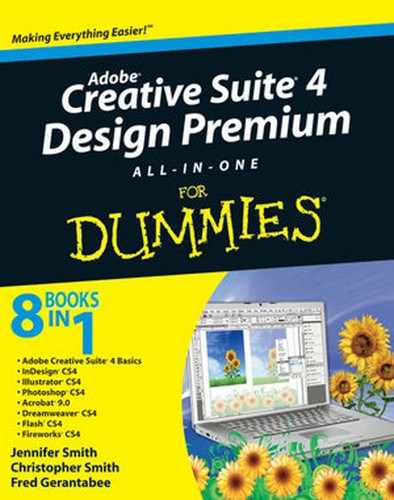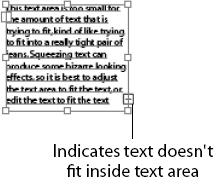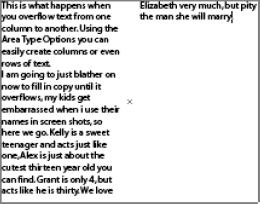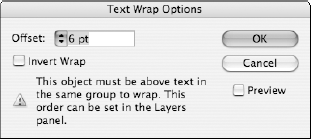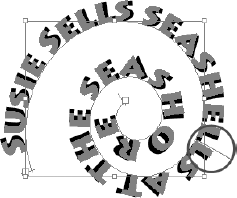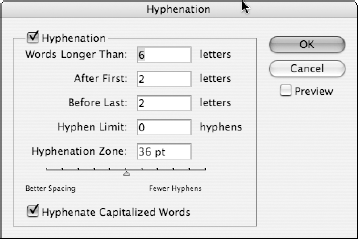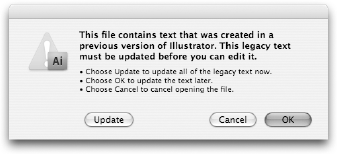One of Illustrator's strongest areas is manipulating text. Whether you're using Illustrator to create logos, business cards, or type to be used on the Web, you have everything you need to create professional text.
In this chapter, you meet the Type tools and discover a few basic (and more advanced) text-editing tricks that you can take advantage of. You then find out about other text tools, such as the Character and Paragraph panels. At the end of this chapter, you get a quick-and-dirty lowdown on the Illustrator text utilities. These utilities can save you loads of time, so don't skip this section.
You can do all sorts of cool things with type, from the simplest tasks of creating a line of text and dealing with text overflow to more complicated tricks, such as placing text along paths and wrapping text around objects.
Figure 6-1 shows the Type tools with an example of what you can do with each one. Click and hold the Type tool to see the hidden tools. The different tools give you the ability to be creative and also accommodate foreign languages.
A text area is a region that you define. Text, when inserted in this region, is constrained within the shape. To create a text area, click and drag with the Type tool.
Tip
As you create and finish typing in a text area, you may want to quickly click and drag a new text area elsewhere on your artboard. Unfortunately, if you're on the Type tool, Illustrator doesn't allow you to do so. You have two options to address this problem:
Choose Select

Hold down the Ctrl (Windows) or

To create a simple line of text, select the Type tool and click the artboard. A blinking insertion point appears. You can now start typing. With this method, the line of type goes on forever and ever (even beyond the end of the Scratch area) until you press Enter (Windows) or Return (Mac) to start a new line of text. This excess length is fine if you just need short lines of text, say for callouts or captions, but it doesn't work well if you're creating a label or anything else that has large amounts of copy.
Warning
Many new users click and drag an ever-so-small text area that doesn't allow room for even one letter. If you accidentally do this, switch to the Selection tool, delete the active type area, and then click to create a new text insertion point.
Select the Type tool and then drag on the artboard to create a text area. The cursor appears in the text area; text you type automatically flows to the next line when it reaches the edge of the text area. You can also switch to the Selection tool and adjust the width and height of the text area with the handles.
Tip
Need an exact size for a text area? With the Type tool selected, drag to create a text area of any size. Then choose Window
Watch out for excess text! If you create a text area that's too small to hold all the text you want to put into it, a red plus sign appears in the lower-right corner, as shown in Figure 6-2.
When Illustrator indicates to you that you have too much text for the text area, you have several options:
Make the text area larger by switching to the Selection tool and dragging the handles.
Make the text smaller until you don't see the overflow indicated.
Link this text area to another, which is threading and is covered later in this chapter in the "Threading text into shapes" section.
The easiest and most practical way to create rows and columns of text is to use the area type options in Adobe Illustrator. This feature lets you create rows and columns from any text area. You can just have rows, or you can just have columns (much like columns of text in a newspaper), or even both.
Select the Type tool and drag on the artboard to create a text area.
Choose Type
Area Type Options.
The Area Type Options dialog box appears, as shown in Figure 6-3. At the end of this section, a list explains all the options in the Area Type Options dialog box.
In the Area Type Options dialog box, enter the desired width and height in the Width and Height text fields.
The Width and Height text fields contain the height and width of your entire text area. In Figure 6-3, 274.03 pt is in the Width text field and 272.73 pt is in the Height text field.
In the Columns area, enter the number of columns you want to create in the Number text field, the span distance in the Span text field, and the gutter space in the Gutter text field.
The span specifies the height of individual rows and the width of individual columns. The gutter is the space between the columns and is automatically set for you, but you can change it to any value you like.
Click OK.
When you create two or more columns of text with the Area Type Options dialog box, text flows to the next column when you reach the end of the previous column, as shown in Figure 6-4.
Tip
The following is a breakdown of the other options available in the Area Type Options dialog box (refer to Figure 6-3):
Width and Height: The present width and height of the entire text area.
Number: The number of rows and/or columns that you want the text area to contain.
Span: The height of individual rows and the width of individual columns.
Fixed: Determines what happens to the span of rows and columns if you resize the type area. When this check box is selected, resizing the area can change the number of rows and columns but not their width. Leave this option deselected if you want to resize the entire text area and have the columns automatically resize with it.
Gutter: The empty space between rows or columns.
Inset Spacing: The distance from the edges of the text area.
First Baseline: Where you want the first line of text to appear. The Ascent option is the default and starts your text normally at the top. If you want to put a fixed size in, such as 50 pts from the top, select Fixed from the drop-down list and enter 50 pt in the Min text field.
Text Flow: The direction in which you read the text as it flows to another row or column. You can choose to have the text flow horizontally (across rows) or vertically (down columns).
Create custom columns of text that are in different shapes and sizes by threading closed shapes together. This technique works with rectangles, circles, stars, or any closed shape and can lead to some creative text areas.
Create any shape, any size.
For this example, we've created a circle.
Create another shape (it can be any shape) someplace else on the page.
With the Selection tool, select one shape and Shift-click the other to make just those two shapes active.
Choose Type
Threaded Text Create.
Create.
A threading line appears, as shown in Figure 6-5, indicating the direction of the threaded text.
Select the Type tool, click the top of the first shape to start the threading, and start typing.
Continue typing until the text flows over into the other shape.
If you don't want the text to be threaded anymore, choose Type
Wrapping text isn't quite the same as wrapping a present — it's easier! A text wrap forces text to wrap around a graphic, as shown in Figure 6-6. This feature can add a bit of creativity to any piece.
Follow these steps to wrap text around another object or group of objects:
Select the wrap object.
This is the object that you want the text to wrap around.
Make sure that the wrap object is on top of the text you want to wrap around it by choosing Object
Arrange Bring to Front.
Bring to Front.
Note
If you're working in layers (which we discuss in Chapter 8 of this minibook), make sure that the wrap object is on the top layer.
Choose Object
Text Wrap Make.
Make.
An outline of the wrap area is visible.
Adjust the wrap area by choosing Object
Text Wrap Text Wrap Options.
Text Wrap Options.
The Text Wrap Options dialog box appears, as shown in Figure 6-7, giving you the following options:
When you finish making your selections, click OK.
If you want to change the text wrap at a later point, select the object and choose Object
If you want to unwrap text from an object, select the wrap object and choose Object
Illustrator gives you the opportunity to change text into outlines or artwork. Basically, you change the text into an object, so you can no longer edit that text by typing. The plus side is that it saves you the trouble of sending fonts to everyone who wants to use the file. Turning text into outlines makes it appear as though your text was created with the Pen tool. You want to use this tool when creating logos that will be used frequently by other people or artwork that you may not have control over.
To turn text into an outline, follow these steps:
Type some text on your page.
For this example, just type a word (say, your name) and make sure that the font size is at least 36 points. You want to have it large enough to see the effect of outlining it.
Switch to the Selection tool and choose Type
Create Outlines.
You can also use the keyboard command Ctrl+Shift+O (Windows) or

The text is now grouped together in outline form.
If you're being creative, or just particular, and want to move individual letters, use the Group Select tool or choose Object
Ungroup to separate the letters, as shown in Figure 6-8.
Warning
When you convert type to outlines, the type loses its hints. Hints are the instructions built into fonts to adjust their shape so that your system displays or prints them in the best way based on the size. Without hints, letters like lowercase e or a might fill in as the letter forms are reduced in size. Make sure that the text is the approximate size that it might be used at before creating outlines. Because the text loses the hints, try not to create outlines on text smaller than 10 pts.
Wow — that's some heading, huh? You've probably seen text following a swirly path or inside some shape. Maybe you think accomplishing such a task is too intimidating to even attempt. In this section, we show you just how easy these things are! There are Type tools dedicated to putting type on a path or a shape (refer to Figure 6-1), but we think you'll find that the key modifiers we show you in this section are easier to use.
Follow these steps to put type on a path:
Create a path with the Pen, Line, or Pencil tool.
Don't worry if it has a stroke or fill applied.
Select the Type tool and simply cross over the start of the path.
Look for an I-bar with a squiggle (which indicates that the text will run along the path) to appear and click.
The stroke and fill of the path immediately change to None.
Start typing, and the text runs on the path.
Choose Window
Type Paragraph and change the alignment in the Paragraph panel to reposition where the text falls on the path.
Paragraph and change the alignment in the Paragraph panel to reposition where the text falls on the path.
Alternatively, switch to the Selection tool and drag the I-bar that appears, as shown in Figure 6-9, to move the text freehand. The path in Figure 6-9 was created with the Spiral tool, which is hidden in the Line Segment tool on the toolbar.
Tip
Flip the text to the other side of a path by clicking and dragging the I-bar under or over the path.
Putting text inside a shape can add spunk to a layout. This feature allows you to custom-create a closed shape with the shape tools or the Pen tool and flow text into it. Follow these steps to add text inside a shape:
Create a closed shape — a circle or oval, for example.
Select the Type tool and cross over the closed shape.
When you see the I-bar swell or become rounded, click inside the shape.
Start typing, and the text is contained inside the shape.
Perhaps you want text to run around the edge of a shape instead of inside it. Follow these steps to have text created on the path of a closed shape:
Create a closed shape, such as a circle.
Select the Type tool and cross over the path of the circle.
Don't click when you see the I-bar swell up; hold down the Alt (Windows) or Option (Mac) key instead.
The icon now changes into the squiggle I-bar that you see when creating text on a path.
When the squiggle line appears, click.
Start typing, and the text flows around the path of the shape, as shown in Figure 6-10.
To change the origin of the text or move it around, use the alignment options in the Paragraph panel or switch to the Selection tool and drag the I-bar to a new location on the path.
You can drag the I-bar in and out of the shape to flip the text so that it appears on the outside or inside of the path.
After you have text on your page, you'll often want to change it to be more interesting than the typical 12-pt Times font. Formatting text in Illustrator isn't only simple, but you can do it multiple ways. In the following list, we name and define some basic type components (see Figure 6-11):
Font: A complete set of characters, letters, and symbols of a particular typeface design.
X height: The height of type, based on the height of the small x in that type family.
Kerning: The space between two letters. Often used for letters in larger type that need to be pulled closer together, like "W i." Kern a little to get the i to slide in a little closer to the W, maybe even going into the space that the W takes, as shown in Figure 6-12. Kerning doesn't distort the text; it only increases or decreases the space between two letters.
Tracking: The space between multiple letters. Designers like to use this technique to spread out words by increasing the space between letters. Adjusting the tracking doesn't distort text; it increases or decreases the space between the letters, as shown in Figure 6-13.
Tip
Pretty good tracking and kerning has already been determined in most fonts. You don't need to bother with these settings unless you're tweaking the text for a more customized look.
Baseline: The line that type sits on. The baseline doesn't include descenders, type that extends down, like lowercase y and g. You adjust the baseline for trademark signs or mathematical formulas, as shown in Figure 6-14.
Note
The keyboard shortcuts for type shown in Table 6-1 work with Adobe Illustrator, Photoshop, and InDesign.
Table 6-1. Keyboard Shortcuts for Type
Command | Windows | Mac |
|---|---|---|
Align left, right, or center | Shift+Ctrl+L, R, or C | Shift+ |
Justify | Shift+Ctrl+J | Shift+ |
Insert soft return | Shift+Enter | Shift+Return |
Reset horizontal scale to 100 percent | Shift+Ctrl+X | Shift+ |
Increase/decrease point size | Shift+Ctrl+> or < | Shift+ |
Increase/decrease leading | Alt+↑ or ↓ | Option+↑ or ↓ |
Set leading to the font size | Double-click the leading icon in the Character panel | Double-click the leading icon in the Character panel |
Reset tracking/kerning to 0 | Alt+Ctrl+Q | Option+ |
Alt+→ or ← | Option+→ or ← | |
Add or remove space (kerning) between characters by 5 times the increment value | Alt+Ctrl+→ or ← | Option+ |
Add or remove space (kerning) between selected words | Alt+Ctrl+ or Backspace | Option+ |
Add or remove space (kerning) between words by 5 times the increment value | Shift+Alt+Ctrl+ or Backspace | Shift+Option+ |
Increase/decrease baseline shift | Alt+Shift+↑ or ↓ | Option+Shift+↑ or ↓ |
To visualize changes that you're making to text and to see characteristics that are already selected, choose Window
Tip
Pressing Ctrl+T (Windows) or
The following list explains the options in the Character panel (see Figure 6-15):
Font: Pick the font that you want to use from this drop-down list.
Tip
In the Windows version, you can click and drag across the font name in the Character panel or Control panel, and press the up- or down-arrow key to automatically switch to the next font above or below on the font list. Do this while you have text selected to see the text change live!
Set font style: Pick the style (for example, Bold, Italic, or Bold Italic) from this drop-down list. The choices here are limited by the fonts that you have loaded. In other words, if you have only Times regular loaded in your system, you won't have the choice to bold or italicize it.
Type size: Choose the size of the type in this combo box. Average readable type is 12 pt; headlines can vary from 18 pts and up.
Leading: Select how much space you want between the lines of text in this combo box. Illustrator uses the professional typesetting method of including the type size in the total leading. In other words, if you have 12 pt and want it double-spaced, set the leading at 24 pts.
Kerning: Use this combo box by placing the cursor between two letters. Increase the amount by clicking the up arrow or by typing a value to push the letters farther apart from each other; decrease the spacing between the letters by typing a lower value, even negative numbers, or by clicking the down arrow.
Tracking: Use the Tracking combo box by selecting multiple letters and increasing or decreasing the space between them all at once by clicking the up or down arrows or by typing a positive or negative value.
Horizontal scale: Distorts the selected text by stretching it horizontally. Enter a positive number to increase the size of the letters; enter a negative number to decrease the size.
Vertical scale: Distorts the selected text vertically. Enter a positive number to increase the size of the letters; enter a negative number to decrease the size.
Warning
Using horizontal or vertical scaling to make text look like condensed type often doesn't give good results. When you distort text, the nice thick and thin characteristics of the typeface also become distorted and can produce weird effects.
Baseline shift: Use baseline shift for trademark signs and mathematical formulas that require selected characters to be moved above or below the baseline.
Character rotation: Rotate just the selected text by entering an angle in this text field or by clicking the up or down arrows.
Rotate: Choose to rotate your selected text on any angle.
Underline and strikethrough: These simple text attributes underline and strikethrough selected text.
Language: Choose a language from this drop-down list. Note: The language you specify here is used by Illustrator's spell checker and hyphenation feature. We discuss these features in the later section, "Text Utilities: Your Key to Efficiency".
Use the Control panel to quickly access your Type tools and Type panels. Note in Figure 6-16 that, when you have active text, hyperlinked text buttons allow you to quickly access panels, such as the Character and Paragraph panels. You can also use this Control panel as a quick and easy way to select fonts, size, alignment, color, and transparency.
Access the Paragraph panel quickly by clicking the Paragraph hyperlink in the Control panel or by choosing Window
You can choose any of the following alignment methods by clicking the appropriate button on the Paragraph panel:
Flush Left: All text is flush to the left with a ragged edge on the right. This is the most common way to align text.
Center: All text is centered.
Flush Right: All text is flush to the right and ragged on the left.
Justify with the Last Line Aligned Left: Right and left edges are both straight, with the last line left-aligned.
Justify with the Last Line Aligned Center: Right and left edges are both straight, with the last line centered.
Justify with the Last Line Aligned Right: Right and left edges are both straight, with the last line right-aligned.
Justify All Lines: This method is forced justification, where the last line is stretched the entire column width, no matter how short it is. This alignment is used in many publications, but it can create some awful results.
You can choose from the following methods of indentation:
First Line Indent: Indents the first line of every paragraph. In other words, every time you press the Enter (Windows) or Return (Mac) key, this spacing is created.
To avoid first-line indents and space after from occurring, say if you just want to break a line in a specific place, create a line break or a soft return by pressing Shift+Enter (Windows) or Shift+Return (Mac).
Right Indent: Indents from the right side of the column of text.
Left Indent: Indents from the left side of the column of text.
By default, the Eyedropper affects all attributes of a type selection, including appearance attributes. To customize the attributes affected by these tools, double-click the Eyedropper tool to open the Eyedropper dialog box.
After you have text in an Illustrator document, you may need to perform various tasks within that text, such as searching for a word to replace with another word, checking your spelling and grammar, saving and creating your own styles, or changing the case of a block of text. You're in luck because Illustrator provides various text utilities that enable you to easily and efficiently perform all these otherwise tedious tasks. In the following sections, we give you a quick tour of these utilities.
Generally, artwork created in Illustrator isn't text heavy, but the fact that Illustrator has a Find and Replace feature can be a huge help. Use the Find and Replace dialog box (choose Edit
Can you believe there was a time when Illustrator didn't have a spell checker? Thankfully, it does now — and its simple design makes it easy to use.
To use the spell checker, choose Edit
If you click the arrow to the left of Options, you can set other specifications, such as whether you want to look for letter case issues or have the spell checker note repeated words.
Note: The spell checker uses whatever language you specify in the Character panel. We discuss this panel in the earlier section, "Using the Character Panel".
Tip
If you work in a specialized industry that uses loads of custom words, save yourself time by choosing Edit
Nothing is worse than severely hyphenated copy. Most designers either use hyphenation as little as possible or avoid it altogether by turning off the Hyphenation feature.
Here are a few things that you should know about customizing your hyphenation settings if you decide to use this feature:
Turning on/off the Hyphenation feature: Activate or deactivate the feature in the Hyphenation dialog box (see Figure 6-17); access this dialog box by choosing Window

Tip
You can also simply click the Paragraph hyperlink in the Control panel to access the Paragraph panel.
Setting specifications in the Hyphenation dialog box: Set specifications in the dialog box that determine the length of words to hyphenate, how many hyphens should be used in a single document, whether to hyphenate capitalized words, and how words should be hyphenated. The Before Last setting is useful, for example, if you don't want to have a word, such as liquidated hyphenated as liquidat-ed. Type 3 in the Before Last text field, and Illustrator won't hyphenate words if it leaves only two letters on the next line.
Setting the Hyphenation Limit and Hyphenation Zone: They're not diets or worlds in another dimension. The Hyphenation Limit setting enables you to limit the number of hyphens in a row. So, for example, type 2 in the Hyphenation Limit text field so that there are never more than two hyphenated words in a row. The Hyphenation Zone text field enables you to set up an area of hyphenation based upon a measurement. For example, you can specify 1 inch to allow for only one hyphenation every inch. You can also use the slider to determine whether you want better spacing or fewer hyphens. This slider works only with the Single-Line Composer (the default).
If you work in production, you'll love the Find Font feature, which enables you to list all the fonts in a file that contains text and then search for and replace fonts (including the font's type style) by name. You do so from the Find Font dialog box (see Figure 6-18), accessed by choosing Type
This cool feature enables you to replace fonts with fonts from the current working document or from your entire system. Select System from the Replace with Font From drop-down list to choose from all the fonts loaded in your system.
Doesn't it drive you crazy when you type an entire paragraph before discovering that you somehow pressed the Caps Lock key? Fix it fast by selecting the text, choosing Type
In Illustrator CS4, you use the same type engine used by InDesign for high-quality text control. As a default, you're working in what is referred to as Single-Line Composer. Select Single or Every Line composer from the Paragraph panel menu.
Single-Line Composer: Useful if you prefer to have manual control over how lines break. In fact, this method had been in place in the past. The Single-Line Composer option doesn't take the entire paragraph into consideration when expanding letter space and word spacing, so justified text can sometimes look odd in its entire form (see Figure 6-19).
Every-Line Composer: The Every-Line Composer option is a very professional way of setting text; many factors are taken into account as far as spacing is concerned, and spacing is based on the entire paragraph. With this method, you see few spacing issues that create strange effects, such as the ones on the left of Figure 6-19.
A text style is a saved set of text attributes, such as font, size, and so on. Creating text styles keeps you consistent and saves you time by enabling you to efficiently implement changes in one step instead of having to select the text attributes for each instance of that style of text (say a heading or caption). So when you're finally happy with the way your headlines appear and how the body copy looks or when your boss asks whether the body copy can be a smidgen smaller (okay ...how much is a smidgen?), you can confidently answer, "Sure!"
If you've created styles, changing a text attribute is simple. What's more, the change is applied at once to all text that uses that style. Otherwise, you'd have to make the attribute change to every occurrence of body text, which could take a long time if your text is spread out.
Illustrator offers two types of text styles:
Character styles: Saves attributes for individual selected text. If you want just the word "New" in a line of text to be red 20 pt Arial, you can save it as a character style. Then, when you apply it, the attributes apply only to the selected text (and not the entire line or paragraph).
Paragraph styles: Saves attributes for an entire paragraph. A span of text is considered a paragraph until it reaches a hard return or paragraph break. Note that pressing Shift+Enter (Windows) or Shift+Return (Mac) is considered a soft return, and paragraph styles will continue to apply beyond the soft return.
You can create character and paragraph styles in many ways, but we show you the easiest and most direct methods in the following subsections.
Create a character style when you want individual sections of text to be treated differently from other text in the paragraph. So instead of manually applying a style over and over again, you create and implement a character style. To do so, open a document containing text and follow these steps:
Set up text with the text attributes you want included in the character style in the Character and Paragraph panels and then choose Window
Type Character Styles.
Character Styles.
The Character Styles panel opens.

In the Character Styles Options dialog box that appears, name your style and click OK.
Illustrator records what attributes have been applied already to the selected text and builds a style from them.
Create another text area by choosing Select
Deselect and using the Type tool to drag out a new text area.
We discuss using the Type tool in the earlier section, "Creating text areas".
Change the font and size to something dramatically different from your saved style and type some text.
Select some (not all) of the new text and then Alt-click (Windows) or Option-click (Mac) the style name in the Character Styles panel.
Alt-click (Windows) or Option-click (Mac) to eliminate any attributes that weren't part of the saved style. The attributes of the saved character style are applied to the selected text.
Note
When creating a new panel item (any panel) in Adobe Illustrator, InDesign, or Photoshop, we recommend that you get in the habit of Alt-clicking (Windows) or Option-clicking (Mac) the New Style button. This habit allows you to name the item (style, layer, swatch, and so on) while adding it to the panel.
Paragraph styles include attributes that are applied to an entire paragraph. What constitutes a paragraph is all text that falls before a hard return (you create a hard return when you press Enter [Windows] or Return [Mac]), so this could be one line of text for a headline or ten lines in a body text paragraph.
To create a paragraph style, open a document that contains text or open a new document and add text to it; then follow these steps:
Choose Window
Type Paragraph Styles to open the Paragraph Styles panel.
Paragraph Styles to open the Paragraph Styles panel.
Find a paragraph of text that has the same text attributes throughout it and put your cursor anywhere in that paragraph.
You don't even have to select the whole paragraph!
Alt-click (Windows) or Option-click (Mac) the Create New Style button (the dog-eared icon at the bottom of the Paragraph panel) to create a new paragraph style; give your new style a name.
Your new style now appears in the Paragraph Styles panel list of styles.
Create a paragraph of text elsewhere in your document and make its attributes different from the text in Step 2.
Put your cursor anywhere in the new paragraph and Alt-click (Windows) or Option-click (Mac) your named style in the Paragraph Styles panel.
The attributes from the style are applied to the entire paragraph.
When you use existing text to build styles, reselect the text and assign the style. In other words, if you put the cursor in the original text whose attributes were saved as a style, it doesn't have a style assigned to it in the Styles panel. Assign the style by selecting the text or paragraph and clicking the appropriate style listed in the Styles panel. By doing so, you ensure that any future updates to that style will apply to that original text, as well as to all other instances.
To update a style, simply select its name in either the Character or Paragraph Styles panel. Choose Options from the panel menu, which you access by clicking the arrow in the upper-right corner of the panel. In the resulting dialog box (see Figure 6-20), make changes by clicking the main attribute on the left and then updating the choices on the right. After you do so, all tagged styles are updated.
Warning
Documents created in older versions of Adobe Illustrator (Version 10 or earlier) contain legacy text, which is text using the older text engine. When these files are opened, you see a warning dialog box, such as the one you see in Figure 6-21.
If you click the Update button, any text on the document will most likely reflow, causing line breaks, leading, and other spacing to change.
Click the OK button to update the file after it's opened to lock down the text. If necessary, you can use the Type tool to click a selected text area to update only the contained text. Another Warning dialog box appears that gives you the opportunity to update the selected text, copy the text object, or cancel the text tool selection. This method is the best way to see what changes are occurring so that you can catch any spacing issues right off the bat. See Figure 6-22 for samples of the three options in the warning dialog box.
Note
If you click Copy the Text Object, you can use the underlying locked copy to adjust the new text flow to match the old. Throw away the legacy text layer by clicking and dragging it to the trash icon in the Layers panel, or click the visibility eye icon to the left of the Legacy Text layer to hide it when you're finished.
